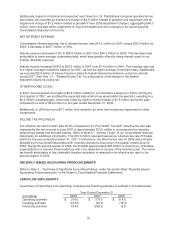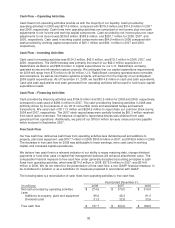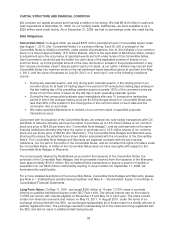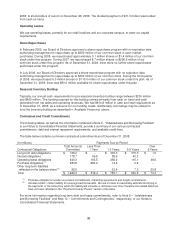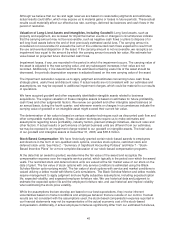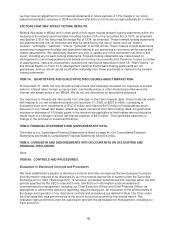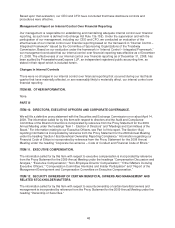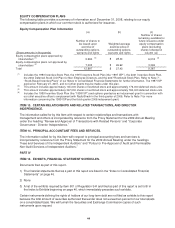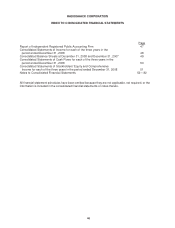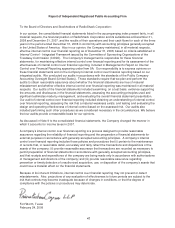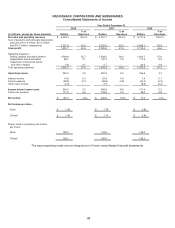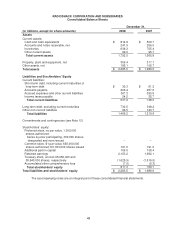Radio Shack 2008 Annual Report Download - page 46
Download and view the complete annual report
Please find page 46 of the 2008 Radio Shack annual report below. You can navigate through the pages in the report by either clicking on the pages listed below, or by using the keyword search tool below to find specific information within the annual report.See the allocation of our restructuring charges within our segments in Note 16 – “Segment Reporting” in
the Notes to Consolidated Financial Statements.
OFF-BALANCE SHEET ARRANGEMENTS
Other than the operating leases described above, we do not have any off-balance sheet financing
arrangements, transactions, or special purpose entities.
INFLATION
With the exception of increased energy costs in 2007 and the first half of 2008, inflation has not significantly
impacted us over the past three years. We do not expect inflation to have a significant impact on our
operations in the foreseeable future.
CRITICAL ACCOUNTING POLICIES AND ESTIMATES
Our consolidated financial statements are prepared in accordance with generally accepted accounting
principles (“GAAP”) in the United States. The application of GAAP requires us to make estimates and
assumptions that affect the reported values of assets and liabilities at the date of the financial statements,
the reported amount of revenues and expenses during the reporting period, and the related disclosures of
contingent assets and liabilities. The use of estimates is pervasive throughout our financial statements
and is affected by management judgment and uncertainties. Our estimates, assumptions and judgments
are based on historical experience, current market trends and other factors that we believe to be relevant
and reasonable at the time the consolidated financial statements are prepared. We continually evaluate
the information used to make these estimates as our business and the economic environment change.
Actual results may differ materially from these estimates under different assumptions or conditions.
In the Notes to Consolidated Financial Statements, we describe our significant accounting policies used in
the preparation of the consolidated financial statements. The accounting policies and estimates we
consider most critical are revenue recognition; inventory valuation under the cost method; estimation of
reserves and valuation allowances specifically related to insurance, tax and legal contingencies; valuation
of long-lived assets and intangibles, including goodwill; and stock-based compensation.
We consider an accounting policy or estimate to be critical if it requires difficult, subjective or complex
judgments, and is material to the portrayal of our financial condition, changes in financial condition or
results of operations. The selection, application and disclosure of our critical accounting policies and
estimates have been reviewed by the Audit and Compliance Committee of our Board of Directors.
Revenue Recognition: Our revenue is derived principally from the sale of name brand and private brand
products and services to consumers. Revenue is recognized, net of an estimate for customer refunds and
product returns, when persuasive evidence of an arrangement exists, delivery has occurred or services
have been rendered, the sales price is fixed or determinable, and collectability is reasonably assured.
Certain products, such as wireless telephone handsets, require the customer to use the services of a
third-party service provider. In most cases, the third-party service provider pays us a fee or commission
for obtaining a new customer, as well as a monthly recurring residual amount based upon the ongoing
arrangement between the service provider and the customer. Fee or commission revenue, net of a
reserve for estimated service deactivations, is generally recognized at the time the customer is accepted
as a subscriber of a third-party service provider, while the residual revenue is recognized on a monthly
basis.
Estimated product refunds and returns, service plan deactivations, residual revenue and commission
revenue adjustments are based on historical information pertaining to these items. If actual results differ
from these estimates due to various factors, the amount of revenue recorded could be materially affected.
A 10% difference in our reserves for the estimates noted above would have affected net sales and
operating revenues by approximately $2.6 million in 2008.
Inventory Valuation: Our inventory consists primarily of finished goods available for sale at our retail
locations or within our distribution centers and is recorded at the lower of average cost (which
39




